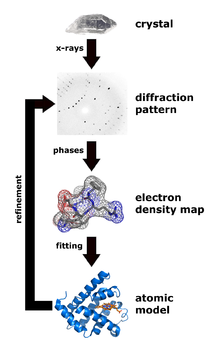
I find science art fascinating. As an X-ray crystallographer, I have access to the esoteric world of protein dynamics. I like to take pictures of the crystals I grow. You can follow me on instagram @babalu_oyvey, but I'm going to post some stuff here too.
For this post, I want to explain how the process works. To crystallize a protein, you first need a gene of interest that you want to learn about. Then we take the DNA for that gene, and shock them into bacterial E. coli cells. Then we give the E. coli a special drug (IPTG) that makes them translate our gene of interest into protein...a lot of protein. Then pop the E.coli cells, and harvest all the proteins. Since scientists are basically gods, we added DNA to the gene that expresses as a sticky tag. The endogenous E. coli proteins do not have this tag. We can then purify our protein of interest by separating the tagged, and un-tagged proteins.
In order for a protein to crystallize, we have to increase the concentration to unnatural levels, and then we have to find the right mixture of chemicals that orients all the proteins into a crystal lattice. After grow the crystals, then we shoot them with X-rays (post picture). The pattern of X-ray diffraction can be used to make a model of the protein (shown in the image below)

I hope someone out there found this interesting and/or informative. Look forward to seeing some of the crystals I have grown, and why. I'm also happy to entertain questions from those who are curious.
-The Scientist
Hi. I found your post very informative, and upvoted/resteemed it.
lol!
However: to increase visibility and impact, you should consider some things:
Downvoting a post can decrease pending rewards and make it less visible. Common reasons:
Submit
wowow, thank you so much. That is great advice. I'm trying to a be an active member, but I am in the middle of trying to publish 3 papers, write my dissertation, then graduate in May. I'll mave more time to put more effort into my posts then. Thank you again.
Downvoting a post can decrease pending rewards and make it less visible. Common reasons:
Submit
you're welcome. 3 papers AND disseration till may? Let me guess: your supervisor's idea of how things should work?^^
Downvoting a post can decrease pending rewards and make it less visible. Common reasons:
Submit
source image: Kaspar Kallip
Downvoting a post can decrease pending rewards and make it less visible. Common reasons:
Submit